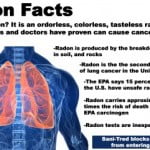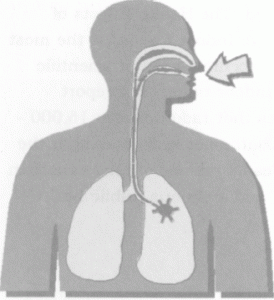When radon gas enters a home, it decays into radioactive particles that have a static charge, which attracts them to particles in the air. These particles can get trapped in your lungs when you breathe. As the radioactive particles break down further, they release bursts of energy which can damage the DNA in lung tissue. In some cases, if the lung tissue does not repair the DNA correctly, the damage can lead to lung cancer. This brings up the question, how much radon is too much?
Does radon gas cause cancer? Not everyone exposed to elevated levels of radon will develop lung cancer, but your risk of getting radon-induced lung cancer increases as your exposure to radon increases (either because the radon levels are higher or you live in the home longer). Smokers who have high levels of radon in homes are at an especially high risk for getting radon-induced lung cancer.
The evidence that radon gas causes lung cancer is extensive and based on: human data taken from studies of underground miners carried out over more than 50 years in five countries, including the United States and Canada; human data from studies in homes in many different nations, including the U.S. and Canada; and biological and molecular studies. This underscores the importance of understanding how much exposure to radon is harmful.
Radon decay particles are breathed into the lungs. Radon is classified as a Class A carcinogen (known to cause cancer in humans) Energy released from radon decay products damages DNA. Some other Class A carcinogens are arsenic, asbestos, and benzene. This classification further emphasizes how dangerous is radon to human health, especially over prolonged exposure.
Is Radon Gas A Health Problem In Homes?
Radon gas is the second leading cause of lung cancer in the United States! Radon causes about 20,000 lung cancer deaths per year, highlighting the critical importance of addressing how much radon is too much in residential settings.
The following is a sample of organizations which state that radon is a health threat in homes:
- U.S. Surgeon General
- American Medical Association
- American Lung Association
- Centers for Disease Control
- National Cancer Institute
- National Academy of Sciences
- Environmental Protection Agency
The risk of developing lung cancer from radon has been clearly demonstrated in underground miners. Did you know that the average lifetime radon exposure for the general population is about the same as the levels of exposure at which increased risk has been demonstrated in underground miners?
A study released by the National Academy of Sciences on February 19, 1998 called “The Health Effects of Exposure to Indoor Radon” is the most definitive accumulation of scientific data on indoor radon. The report concludes that radon causes 15,000 – 22,000 deaths per year, making it the second leading cause of lung cancer in the U.S. and a serious public health concern. This report further underscores how dangerous is radon and the importance of mitigating exposure to reduce health risks.
Have You Heard Of Stanley Watras?
Stanley J. Watras was a construction engineer at the Limerick nuclear power plant in Pottstown, Pennsylvania. One day, on his way to work, he entered the plant and set off the radiation monitor alarms which help protect workers by detecting exposure to radiation. Safety personnel checked him out, but could not find the source of the radiation. Interestingly, because the plant was under construction at the time, there was no nuclear fuel at the plant. They discovered the source of radiation exposure when Watras’s home was tested and was measured to have very high radon gas levels (2,700 pCi/L).



